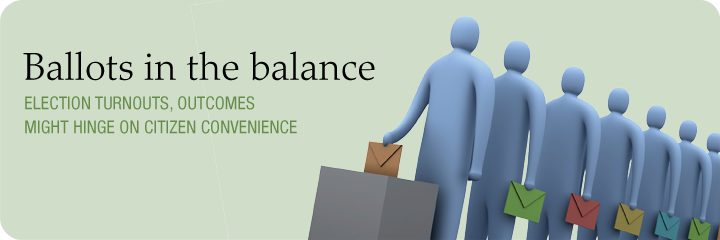
When millions of people cast votes in an election, a single ballot might not seem to count for much. In recent years, though, U.S. presidential candidates have run such tight races that the outcome has turned on a handful of votes in a single state. Think of George W. Bush’s 2 percent margin in Ohio in 2004, or his much smaller — and highly controversial — margin in Florida in 2000.
As the 2008 presidential primaries wind down and the general election draws near, memories of past elections point out the fact that in a close race, every vote really does matter. That’s why the losing side in a squeaker contest might challenge the accuracy of the tally, the performance of voting machines or the handling of absentee ballots, not to mention any factors that might have kept some voters from going to the polls.
And it’s why election officials would like to push voter turnout as close as they can to 100 percent. “The outcome of a high-turnout election is perceived as having greater legitimacy than one with low turnout because the voters are presumed to be more representative of the entire population,” said John E. McNulty, assistant professor of political science at Binghamton University.

A good deal of McNulty’s research seeks to define the circumstances that boost or depress voter participation. In 2006, McNulty and Henry E. Brady, professor of political science and public policy at the University of California, Berkeley, received $165,000 from the National Science Foundation to expand their work in this area.
McNulty and Brady have been examining how voters respond when a county reduces the number of polling locations used in an election. They’re developing a book on the subject, which should help election officials understand how decisions to open or close polling spots will influence turnout.
“They’ll know exactly what to expect when they make any changes,” McNulty said. “In addition, when they open new polling places or have any kind of voter outreach, they’ll have a pretty good idea of how much additional turnout that might generate, so they can be better prepared for it.”
A major assumption behind the study is that when you change a voter’s polling place, you make voting less convenient. Inconvenience is one of many elements that make up the “cost” of voting. In general, the cost of voting includes any opportunity a voter gives up in order to cast a ballot — perhaps the chance to play with one’s children, take a shorter route home from work or watch a rerun of a favorite television show.
When people decide whether to vote, they do a cost/benefit analysis. And for many of us, the direct benefit of voting is not too compelling. “In many cases, you don’t perceive that the outcome of the election will have a tangible effect on your life,” McNulty said.
“When you take that cost into account, versus the potential benefits, in purely mathematical terms, nobody should vote. Because there’s more value to you in sitting down and watching an episode of Seinfeld than there is benefit, in thin rational terms, in casting a vote at all,” he said. It’s not the expectation of benefit, but other factors, such as a sense of duty, that make many citizens overlook the costs and head for the polls.
McNulty’s and Brady’s initial research sprang from the 2003 special election that recalled California Gov. Gray Davis and put Arnold Schwarzenegger in his place. “Running a statewide election in a state the size of California costs a fortune,” McNulty said. And in this highprofile contest, with famous actors, a porn star and the former commissioner of Major League Baseball on the slate, high turnout was likely to push the price tag even higher.
Because it was a special election, though, with no contests for city council, county supervisor or the like, every voter in the state would be looking at exactly the same ballot choices. Since counties didn’t have to tailor ballots to local needs, in theory an individual could vote anywhere. Counties could save money by opening polls in fewer locations.
Los Angeles County, the state’s largest, cut the number of polling places from about 5,000 to 2,000. “This saved something on the order of $10 million,” McNulty said.
page 1 | page 2